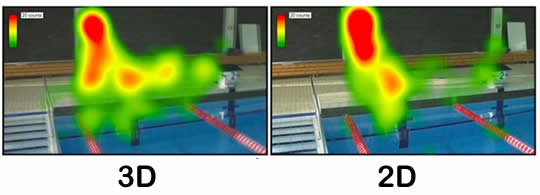3D Commercials, Different Dynamics
3D entertainment has finally gone mainstream. Although three dimensional movies have existed for decades, they were largely gimmicky and had significant viewing problems. Now, James Cameron’s Avatar brought 3D to the big screen in a way that amazed audiences and convinced studio execs that the world was ready for 3D movies. Building on the Avatar buzz, 3D television sets were big news at the 2010 Consumer Electronics Show. With a surge in 3D entertainment, we can expect an onslaught of 3D advertisements to accompany the programming. Advertisers who start producing 3D commercials can’t assume that all they need to do is change out a standard camera for a 3D setup – eye tracking data shows that people who view the same scene in 3D vs. 2D look at different things.
The image above shows eye-tracking “heat maps” for the same image viewed in 3D (left) vs. 2D (right). The Finnish and Japanese authors of the study, What do people look at when they watch stereoscopic movies?, found that when viewing 3D movies viewers gaze is less focused. There is more eye movement, and they take in more elements of the scene. For advertisers, the Neuromarketing takeaway is that visual elements that would be ignored as merely part of the background in a 2D commercial might grab the attention of the viewer in 3D.
Presumably some of this change in behavior is driven by the novelty of 3D entertainment, and soon we’ll be so accustomed to 3D content that we again tune out the background almost completely. In the meantime, though, creators of 3D commercials would be well advised to keep distracting elements out of the shots where they want attention to be focused on the actor(s) or product.
(Via James Breeze.)

